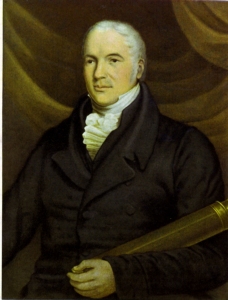William Scoresby Senior (1760-1829) Bagdale
During the late 18th and early 19th centuries Whitby was a prosperous port with booming shipbuilding and whaling industries. Two of the most successful whaling captains were William Scoresby senior and his son, the Reverend Dr William Scoresby junior.
William Scoresby Senior (1760-1829) was the son of a yeoman farmer from Nunholme, Cropton near Pickering. At the age of 9 he worked on his father’s farm. In 1780 he was apprenticed on the vessel ‘Jane’, owned by the Chapman family. Following a number of adventures he returned to his native village and married a local girl Mary Smith, he remained at Cropton for 2 years. He later became employed in the Greenland Whaling trade signing on the Henrietta under Captain Crispin Bean. During his six voyages he rose to become Second Officer and in 1790 became Captain. He became Whitby’s most noted figure associated with whaling during the years 1793-97. William Scoresby Junior (1789-1857) was apprenticed to his father aged 13. At 17 he was promoted to Chief Mate and at 21 he replaced his father as captain of the Henrietta.

In 1807 during his years as Artic navigator aboard The Dundee. He invented the crow’s nest to provide shelter from the terrible weather conditions for the navigator at the top of the main mast. He retired from whaling in 1823.
On one of his voyages he brought back many polar bears, one of which he brought back to Whitby and kept in the harbour near his first residence at Scoresby House on Church Street, which is located on Church Street at the bottom of Salt Pan Well Steps. He took an active role in the affairs of Whitby and was greatly concerned with social issues regarding the high unemployment in Whitby. William died at his house at 13 Bagdale, where Whitby Civic Society have recognised his achievements with a Blue Plaque.
A local man Jack Lammiman was determined to pay homage to William Scoresby Snr, Whitby’s great 18th century Skipper, who had invented the Crow’s Nest. So in 1991 he made the epic voyage to the Arctic in his old Danish fishing boat the Helga Maria with a party of pensioners and a Vicar on board. He set off despite British officials banning him from leaving the port of Whitby because they considered his vessel not to be seaworthy. They braved stormy seas and had an encounter with a polar bear. They repainted the vessel to disguise it from pursuing Royal Navy spotter planes. The motley crew returned to Whitby in triumph to be greeted by thousands of August Bank Holiday visitors, but officialdom prevailed and Captain Jack was prosecuted by the Department of Transport and convicted of breaching maritime safety regulations.
His antics were the inspiration for the film Captain Jack, which was partly filmed in Whitby in 1997 with award winning actor Bob Hoskins playing Jack. Even though the adventure was made into a film, the real Captain Jack Lammiman shunned the limelight and slipped back into obscurity in Whitby. The Helga Maria was sold and Captain Jack, a charismatic figure, would often be seen by the harbourside walking his dogs and smoking his pipe.
What would William Scoresby have made of Jack? I think he would have admired his determination and skill.
Source: Val Appleton
Whitby Museum has an extensive collection of objects and papers linked to Arctic whaling and to the Scoresby family.
